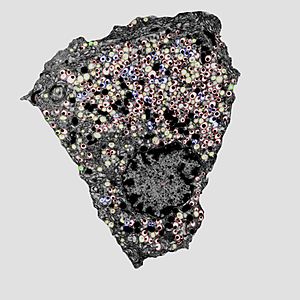Granule (cell biology) facts for kids
Inside our bodies, tiny parts called cells are like busy factories. A granule is like a very small storage bag or container inside a cell. These tiny bags hold important things that the cell needs to use or send out. You can barely see them even with a strong microscope!
What are Granules?
Granules are super tiny structures, often shaped like little bubbles or sacs. They are found inside many different kinds of cells. Think of them as mini-warehouses that store special chemicals, proteins, or other substances. When a cell needs to use these stored items, the granules release them. This process is called "secretion."
Granules in Your Immune System
Our bodies have an amazing defense system called the immune system. It works hard to fight off germs and keep us healthy. A big part of this system is made of white blood cells, also known as leukocytes.
Some white blood cells are called granulocytes because they are full of these tiny granules! These granules contain special chemicals that help fight infections. For example, some granules can release substances that destroy harmful bacteria or viruses.
There are also special cells called Natural killer cells. Their granules contain powerful tools that can help destroy cells that are infected or have gone wrong, like some unhealthy cells in your body.
Granules in Blood Clotting
When you get a cut, your blood needs to stop flowing. This is where tiny cell pieces called platelets come in handy. Platelets are like tiny repair workers that help your blood clot.
Platelets also have granules! They have two main types: dense granules and alpha granules. These granules store important substances that help the blood clot quickly. For example, they release chemicals that make other platelets stick together and form a plug, stopping the bleeding.
See also
 In Spanish: Gránulo (biología celular) para niños
In Spanish: Gránulo (biología celular) para niños


